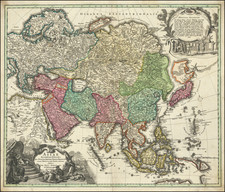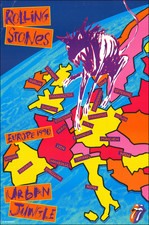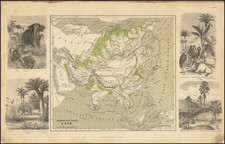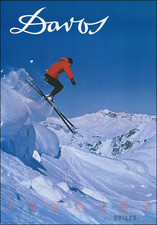Large 1946 Edition of Boucher's Iconic Phoenix
In the aftermath of World War II, Lucien Boucher created this remarkable travel poster for Air France. Featuring a mythical Phoenix ascending ahead of an Air France Constellation, the poster exudes an allure that was both exotic and aspirational. Superimposed over a map of Asia showing images reminiscent of India and China, the striking colors and vivid imagery have become an iconic symbol of Boucher's work.
This striking visual tapestry served a practical purpose—namely, to encourage travel to China and the Far East in the aftermath of World War II.
Printed by Perceval Paris, the poster reflects Boucher's capacity to meld commercial objectives with high art, imbuing the travel landscape with a sense of wonder and adventure. In capturing the imagination of prospective travelers, Boucher's poster played a critical role in defining Air France's brand as the conduit to exotic, far-reaching locales during a period of international rebirth and discovery.
States of the Poster
The poster comes in two sizes, this 1946 large format and a more common smaller state issued beginning in 1948.
This early large image is approximately 4 times the size of the smaller poster.
Lucien Boucher (1889-1971) was a French artist whose work spanned various mediums including cartooning, painting, and illustration. Born in Chartres and educated at the École de Céramique de Sèvres, Boucher initially focused on ceramics before World War I significantly altered his artistic trajectory. His period of captivity as a prisoner of war during the conflict led him to discover and hone his skills in drawing, thereby shaping his future career.
Before the war, Boucher had already begun to make a name for himself in the French art scene, particularly through his cartoons published in the weekly magazine "Le Rire." His early works demonstrated his capability for visual satire, but his subsequent experience in the war led to a more serious engagement with themes and subjects. After his return, Boucher navigated toward commercial illustration and poster design, successfully integrating his artistic sensibilities with the needs of the market.
Starting in the 1920s, Boucher began to produce a series of posters that drew inspiration from the surrealism movement. This work culminated in his most well-known project: a series of planispheric and celestial maps designed for Air France. These maps served a dual purpose. While they were essentially utilitarian, providing navigational information, they were also aesthetically innovative. Boucher employed elements of surrealism to add layers of meaning, transforming what could have been straightforward maps into more complex visual narratives.
Boucher's work with Air France solidified his reputation as an artist who could balance commercial needs with artistic innovation. His approach to map-making was characterized by a careful attention to detail, a strong sense of composition, and a willingness to explore the boundaries of the medium. While his maps were intended to serve a practical function, they also succeeded in capturing the public's imagination, offering a vision of travel that was aspirational yet grounded in geographical realities.












![[ Sichuan and Shaanxi ] Suchuen et Xensi, Provincia seu Praefecturae Regni Sinensis . . .](https://storage.googleapis.com/raremaps/img/small/95627.jpg)

![Повстанцы 1863 Года [(Polish) Insurgents of 1863]](https://storage.googleapis.com/raremaps/img/small/52719.jpg)

